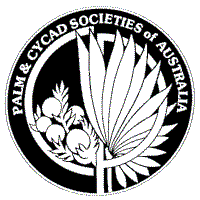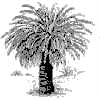|
Cycads
Cycas revoluta-odd |

| |||
|
| ||||
Cycas revoluta
is undoubtedly the best known
and most popular cycad in the
world. Despite this, not much has been
known until recently about the wild
populations. Last year, the authors published
a comprehensive account of the species
(Osborne & Tomiyama 1995). Several
hundred thousand specimens of Cycas
revoluta occur in a scattered distribution
pattern from the southernmost part of
Kyushu and throughout the Ryukyu
Islands, mostly growing on near-vertical
coastal cliffs (Figure 1) or on the sides of
limestone mountains.
 |
Figure1. Cycas revoluta
plants on near-vertical coastal cliffs near
Kogashima, southern Kyushu towards the northern end of the species
distribution range. The mountain in the background is Kaimon-dake,
a volcano which last erupted in the 9th Century. Photo: Takashi Maruoka, in Shukan Asahi Hyakka Sekaino Shokubutsu , December 1977. |
The Japanese people have a special empathy for this plant, extending back over many centuries, and both wild and cultivated representatives of the species comprise an intimate part of Japanese culture.
Of particular interest is the diverse range of cultivars much favoured by Japanese horticulturists but not well-known outside Japan. A description of these fascinating and often bizarre forms was given by Toshihiko Satake (Satake 1981).
Satake listed nine cultivars in the following classification:
-
Cycas revoluta
var. cristata
(Japanese:
tosaka, shishi-sotetsu, mayaa-sutichi
or
mayaa-sotetsu
). This is a rare form having
a laterally-spreading trunk apex so that
the stem becomes two-dimensionally fanshaped,
like a cockscomb. It is particularly
dramatic when this development
extends in the same way to the production
of crested line of male cones (Figure 2).
The origin of the crested form is uncertain;
it may be that damage to the
meristematic region causes the abnormal
cell proliferation. Plants with this aberration
are sometimes found naturally in sites
where typhoon damage is experienced,
while in other cases they are obtained as
suckers from "normal" plants.
Figure 2. The fan-shaped cluster of male cones on a crested form of Cycas revoluta at the Shenzhen Fairy Lake Botanical Garden, Guangdong, China.
Photo: Ding-yue Wang.
-
Cycas revoluta
var. diplofoliolum
(Japanese: matsuba-sotetsu
). In this form some
or all of the leaflets are dichotomously
forked (bifid) from a point about halfway
along their length or closer towards the tip.
The percentage of bifid leaflets increases
towards the petiole and occasionally the
leaf rachis itself is branched. The
diplofoliolum
form carries its mutation genetically,
i.e. seeds from bifid-leaved parent plants
will also bear bipinnate leaflets.
Specimens with a high percentage of bifid
leaflets, and those with very prominent
forks, are especially sought after by Japanese collectors.
- Cycas revoluta
var. corrugata
(Japanese: chirimen-sotetsu). This rare cultivar
has vertical stripes on the leaf and bract
bases, and is often associated with a bottle-shaped
lower trunk.
-
Cycas revoluta
var. variegata
(Japanese:
fuiri-sotetsu
). This is probably the
best-known of the cultivars and represents
a wide range of plants in which there are
various degrees of yellow/green leaf variegation
patterns. Sometimes a whole leaf
is yellow, sometimes some of the pinnae
are yellow and others green, and sometimes
the individual pinnae are part yellow and
part green. Various mixtures of all these
sometimes occur on a single plant, so that
each specimen is unique (Figure 3). Seed
production from variegated plants gives a
large proportion of normal plants together
with a much smaller number of albinos and
variegated plants; hence propagation of
these forms is best accomplished by selecting
and rooting suckers which show good
colour potential.

Figure 3. A splendid example of a varigated Cycas revoluta , in the large collection cultivated by Mr. Masayuki Ishigaki, Ishigaki-Jima, japan.
Photo: Masayuki Ishigaki. -
Cycas revoluta
var. alba
(Japanese:
shiroba-sotetsu
or ougon-sotetsu
). The
epithet alba
is something of a misnomer
as the second Japanese name is translated
as the "golden cycad". This is a variation
of the variegated form, but in these rare
and unusual specimens, the entire crown
of leaves is pale yellow on emergence (Figure 4).
The yellow colour initially darkens
during the summer but later the leaves
gradually become green and hence
photosynthetically productive.
Figure 4. One of the most impressive of the Cycas revoluta mutants is this specimen which bears great flushes of sulphur-yellow leaves, these later becoming green and photosynthetic. This plant was found on a precipice on Kume-Jima island some 25 years ago, and is now in cultivation in the garden of Mr. Seisyun Itokadzu, Deputy Mayor of Gushikawa-son village, Kume-Jima, Okinawa.
Photo: Seisyun Itokadzu.
- Cycas revoluta
var. aurea
(Japanese:
kogane-sotetsu
). In this form, it is only
the tips of the pinnae which have a
golden-yellow colour. In Amami, these plants
have the yellow tips on emergence (Figure
5) and they wither during the autumn. In
other examples, the leaves are green on
emergence and develop permanent yellow
tips subsequently.

Figure 5. An example of Cycas revoluta forma aurea from Amami, Japan. In these specimens, the tips of the pinnae are yellow on emergence but become brown as the leaf matures.
Photo: Hajime Tomiyama. - Cycas revoluta
var. hystrix
(Japanese:
hari-sotetsu
). Here, the leaf bracts are
adorned with long and persistent prickles.
-
Cycas revoluta
var. involuta
(Japanese:
tako-sotetsu
). This is a form in which the
leaflet tips remain rolled inwards (i.e. involute)
to varying degrees. The pinnae are
also entirely covered with brownish hairs
which creates a somewhat morbid-looking
appearance.
- Cycas revoluta
var glabra
(Japanese:
aoe-sotetsu
). This is an extremely rare
form where the back of the leaf, petiole
and petiole base is completely glabrous and
greenish, the whole plant thus having a
very "smooth" appearance.
Apart from these nine cultivars, there has
always been an enormous interest in the
use of
Cycas revoluta
for bonsai, especially
of course, in Japan (Hodge 1973). These
specimens are variously referred to as
dwarf Cycas
, mini-Cycas
or C. revoluta
forma/var. nana
(Japanese: ryukyu-sotetsu
or kumeyama-sotetso
(Figures 6 & 7).
They cannot be regarded as cultivars in the
sense of the nine forms described about,
but are in most cases the products of
skillful manipulation over decades or even
centuries, in the typical and painstaking bonsai
art-form. Growth rates are usually
limited to about 10 cm in 20 years.
| Figure 6.
Cycas revoluta
in the bonsai style. Photo: Hajime Tomiyama. |
 |
 |
Figure 7. Part of a collection of bonsai specimens of Cycas revoluta
. Photo: Hajime Tomiyama. |
Cycas revoluta will undoubtedly continue its popularity as a garden and container specimen, but the oddities described in this article add a new and interesting dimension to the species. While a very limited number of such plants have found their way into collections in China, the USA, and Australia, it is hoped that these will become more widely accessible to other collectors outside Japan in due course.
 |
Figure 8. The Golden Cycas
of Japan in habitat on a small island near
Okinawa in the Ryukyus. Photo: Hajime Tomiyama. |
C. revoluta "Semi-Crested"

Figure 9.
C. revoluta
"semi-crested"

Figure 10. C. revoluta
"semi-crested"
C. revoluta forma "aurea"

Figure 11.
C. revoluta
forma "aurea"

Figure 12. C. revoluta
forma "aurea"
When the leaves start to die back you have two options:
The dieback of the golden yellow tips is a gradual process that occurs naturally.
| Links: | Variegation in Cycads |
| References: | Hodge, W.H. 1973. Satake-san's cycads. Fairchild Tropical Garden Bulletin 28(4): 4-5. |
| Osborne, R. & Tomiyama, H. 1995. Focus on....Cycas revoluta . Encephalartos 41: 5-15. | |
| Satake, T. 1981. The varieties of Cycas revoluta . Cycad Newsletter 4(3): 3-10. | |
| Contributed by: | Roy Osborne (Text) |
| Hajime Tomiyama2 - 266-2 Oh, Yomitan-son, Okinawa 904-03, Japan (Text) | |
| Craig Thompson (Text - C. revoluta forma "aurea") | |
| Paul Kennedy (Figure 9&10) | |
| Masood Siddiqui (Figure 11&12) |
| For further information try | |||||||||
 |
 |
|
VCE |
 |
 |
||||
 |
 |
 |
 |
 |
 |
||||